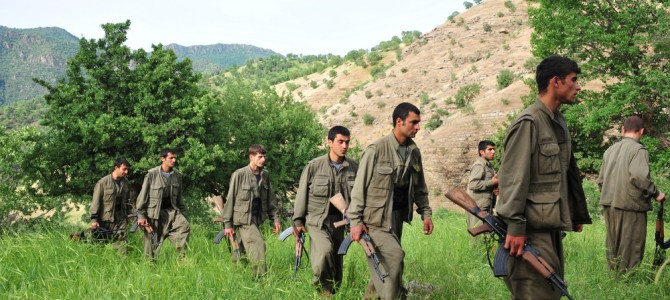
In the past several weeks Palestinians have been attacking Israelis in the streets with knives. While John Kerry flies around the world trying ineffectually to calm the situation, and Palestinian Authority leader Mahmoud Abbas calls for the blood of the Israelis, a provocation of continued violence is coming from a new corner of the Middle East.
Last week, the self-proclaimed caliphate ISIS released a video threatening Israelis. The Hebrew-speaking man in the video stated, “Soon there won’t be even one Jew left in Jerusalem.” He warns them, “We are advancing toward you from every place. From the north, from the south…we will come to annihilate you.” In addition to spurring on the violent uprising occurring the past few weeks, ISIS joins with Iran and al-Qaeda in calling for the destruction of Israel.
Beyond broadcasting their unsurprising violent intentions toward Israel, this video reveals something interesting about the nature of ISIS. It contradicts certain ideas about the goals of the so-called Islamic State.
Some, like Graeme Wood, have argued we don’t need to worry about ISIS in the same way we have had to worry about al-Qaeda because ISIS, unlike al-Qaeda, is concerned with setting up a physical caliphate in Mesopotamia and expanding contiguously from there. They have no intention of attacking America or Europe, even if global domination is the ultimate objective. Of primary concern is maintaining the physical caliphate.
This is indeed their stated goal. However, this view fails to understand that ISIS is not just interested in establishing the traditional, territorial caliphate, although this is a necessary requirement. They are creating a digital caliphate as well.
The Phenomenon of Online Nationalism
ISIS deftly distributes their ideology through social media and slick production value. They know how to message to disaffected young men and women: what kind of content, where and when. They can reach beyond the physical borders of the caliphate and create a digital community of national and religious adherents.
The phenomenon of online nationalism has been occurring for the last few decades among immigrant communities dispersed throughout the world. Groups of first, second, and third-generation immigrants participate in what is often referred to as a digital diaspora or a digital nation. In the globalized Internet age, the diaspora can partake in an online community that allows them to experience a shared national identity with people of similar backgrounds. This is based not only on country of origin, but also on ethnolinguistic and religious solidarity.
This digital diaspora, although often originating from a country with physical borders, is able to gather outside of them. They engage in a digital nationalism. A diaspora group can be spread across several countries and continents, as in the case with the Syrian and Iraqi diaspora, or they might be concentrated in one country, as in the case of the Maghrebi diaspora in France. The pan-Arabism movement (i.e. Nasserism sans the political goals) has flourished in the wake of the Internet age, particularly via social media.
A Nationalism Beyond Borders
The reason that virtual nationalism is so powerful is that nationalism isn’t built solely on territorial boundaries. Traditionally there have been two types of nationalism: German and French. The German model was based on a shared ethnolinguistic heritage. You’re either German or you’re not, but nothing you do can change that. In many cases, language is more important in nationalist ideology than territory. This is the kind of nationalism that many Arabs and Muslims express.
French nationalism, on the other hand, was based on a pact with the state. If you entered into a contract with the state, you became a French national. Things have changed culturally in France so that the French model has moved much closer to the traditional German model, with language and ethnicity being of tantamount importance in what it means to be “French.”
ISIS is having it both ways. They have staked claim to a physical nation, in Syria and Iraq, while also giving birth to a digital one. They have created this digital nation based on three of the most powerful factors in the construction of identity: ethnicity, language, and religion. They appeal to the Arab diaspora community that is spread throughout the Western world, especially its youth, who are often disaffected and unmoored.
ISIS offers them an opportunity to belong to something bigger, to have a strong sense of national identity, and to be a part of history in their participation in the first caliphate in generations. Many European Muslims feel little or no allegiance to the countries in which they live. Thus ISIS offers them a kind of citizenship they can embrace. And all this without having to move or quit their job. In this way, ISIS is reaching well beyond its Syrian-Iraqi territory, recruiting “citizens” from across the world who will never set foot in the traditional lands of the caliphate.
ISIS Everywhere
This is notable because, doctrinally, Muslims who have pledged themselves to the caliphate are supposed to actually live in the caliphate if possible. Yet ISIS is now training men to go back to their countries to fight against their non-Muslim governments. This is what is happening with young French men, causing France to begin finally taking a more active role in fighting ISIS.
This indicates either a shift in ideology (which is doubtful) or, more likely, a shift in strategy. In addition to expanding in a contiguous manner, ISIS sees the value of cross-continental simultaneous activity.
The most recent proof of ISIS’s reach beyond the fight to expand its territory contiguously is its pledge of violence against Israel. Not only are they promising Israel’s destruction, implying direct involvement, but they are also implicitly calling on Muslims, coming from all directions, “north and south,” to attack Israelis. The video paints a picture wherein Israel is surrounded, because ISIS is everywhere.
A digital caliphate does not nullify the need for a territorial one. According to one of the Hadiths, if a Muslim dies without pledging his or her allegiance (baya’a) to the caliphate, he or she dies a “death of disbelief” (jahil). ISIS, therefore, has to retain a physical territory because a caliphate cannot exist without territorial authority. This is what binds and anchors peoples’ pledges of allegiance.
We live in an age of technology that could never have been conceived of when the Ottoman Empire was dismantled at the end of World War I and the last caliphate abolished in 1924. ISIS is the twenty-first-century version of the caliphate, with well-educated and savvy tech teams who understand clickbait, know what draws people in and how to produce it. They have the technology and the know-how to construct this digital nation, and that’s exactly what they’re doing.
We can’t combat an enemy we don’t see. If we want to destroy ISIS, it won’t be enough to bomb their territories in Iraq and Syria. It won’t even be enough to put “boots on the ground” in Iraq, as Secretary of Defense Ash Carter recently suggested. We will need to look beyond Iraq and Syria and understand ISIS as a global movement and something entirely new to history: a digital caliphate.









